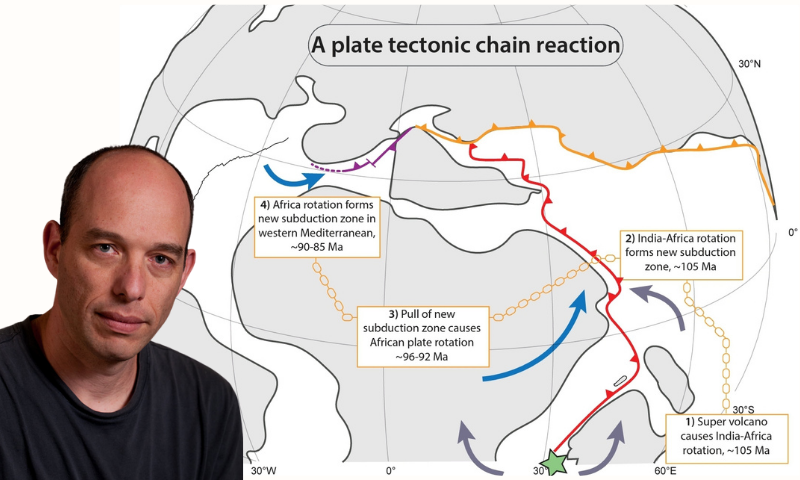Dutch, Israeli and Australian geologists are working hard to unravel the secrets of plate tectonics, the mechanism that continuously shapes Earth's crust and causes earthquakes and volcanic eruptions. Now, another mystery has been revealed. Earlier research showed that changes in movement between plates can result from continental collisions, rising mantle plumes, or the formation of subduction zones. But could such geodynamic events set off a global chain reaction? Now geologists have succeeded in finding evidence that supports this hypothesis.
"With this discovery, we are able to better understand the driving forces behind plate movements, and thus processes such as mountain formation or volcanism," the researchers say.
Their findings, just published in Nature Geoscience, were the product of a collaboration between geoscientists from Utrecht University, Australian National University, and Ben-Gurion University of the Negev.
To test their hypothesis, the researchers asked themselves the following question: did the formation of a new subduction zone north of Arabia that itself was triggered by a ~100 Ma mantle plume set off a chain reaction? Utrecht Prof. Douwe van Hinsbergen, geologist, former Utrecht PhD student and first author Derya Gürer, and Ben-Gurion University Prof. Roi Granot, analyzed the sequence of plate tectonic events step by step.
"If our hypothesis is correct, the new subduction zone that formed north of Arabia caused forces that accelerated and rotated the African Plate in the 10 million years after subduction initiation. However, to analyse this, we had to solve a major problem," says Gürer.
Quiet zone
Like a tape recorder, the chronicle of past plate motions is archived in the oceanic crust's magnetization. As soon as magma reaches the surface at mid-ocean ridges and cools into rock, their iron-bearing minerals align with and store the Earth's ambient magnetic field. The polarity of Earth's magnetic field repeatedly reversed through geological time resulting in a mirror symmetry of parallel stripes moving away from the mid-ocean ridge. The crust of the oceans therefore allows us to reconstruct the movement of tectonic plates in the distant past.
But in the Late Cretaceous period between 126 and 83 million years, there were no reversals of the magnetic field. "In the oceanic crust that formed in this period, the magnetic field is pointing in the same direction everywhere. It forms the so-called magnetic Quiet Zone," van Hinsbergen explains. Until recently it was impossible to reconstruct plate movement changes within this mysterious time interval. But 10 years ago, Prof. Granot discovered that the rocks in the Central Atlantic Quiet Zone did record abrupt changes in magnetic noise.
"By applying the methods that we normally use for magnetic reversals to magnetic noise variations, we were able to greatly improve the temporal resolution of the plate model. It showed that the African plate did indeed accelerate and rotate when the new subduction zone started pulling," says Granot.
This rotation in turn caused a sequence of tectonic events, including a new subduction zone in the Western Mediterranean, which in turn pulled the western Mediterranean apart.
"This is the first time that evidence has been found for a plate tectonic chain reaction. With this research, we have dissected a mechanism to explain why there are short periods of time in which plates suddenly change direction. These plate movements affect mountain formation, marine gateways, ocean circulation patterns, volcanism, and even the global climate," says Gürer.
This study was supported by the Israel Science Foundation (ISF) grant no. 1923/21 and Nederlandse Organisatie voor Wetenschappelijk Onderzoek (Netherlands Organisation for Scientific Research).
Article
Derya Gürer, Roi Granot, Douwe J. J. van Hinsbergen, 'Plate tectonic chain reaction revealed by noise in the Cretaceous Quiet Zone', Nature Geoscience

Above: A plate tectonic chain reaction Credit: Prof. Roi Granot
Media Coverage:
The Times of Israel
Haaretz